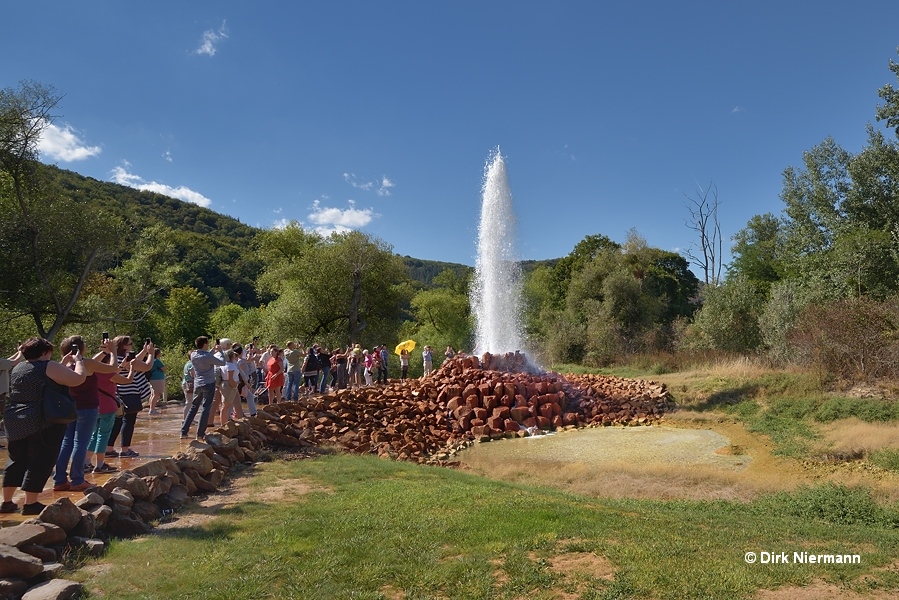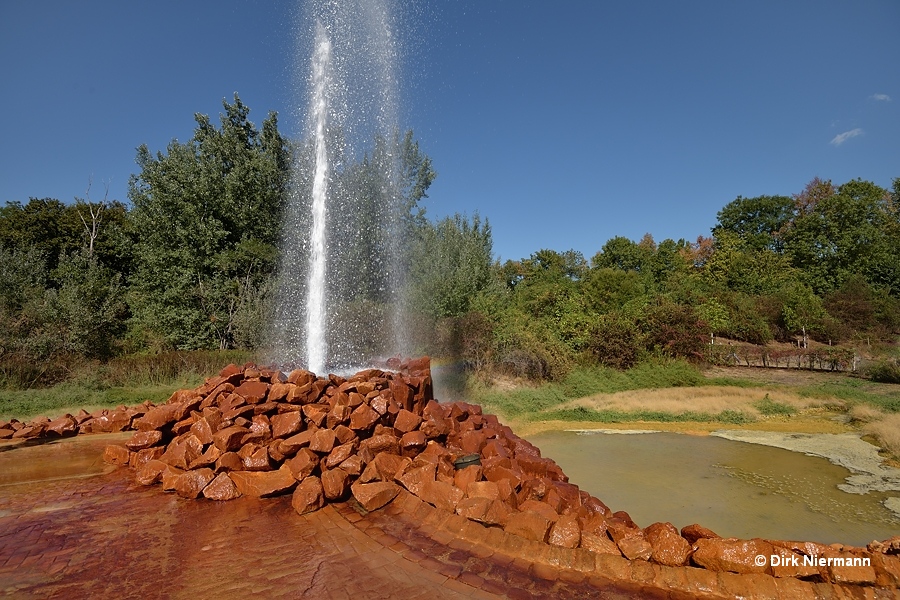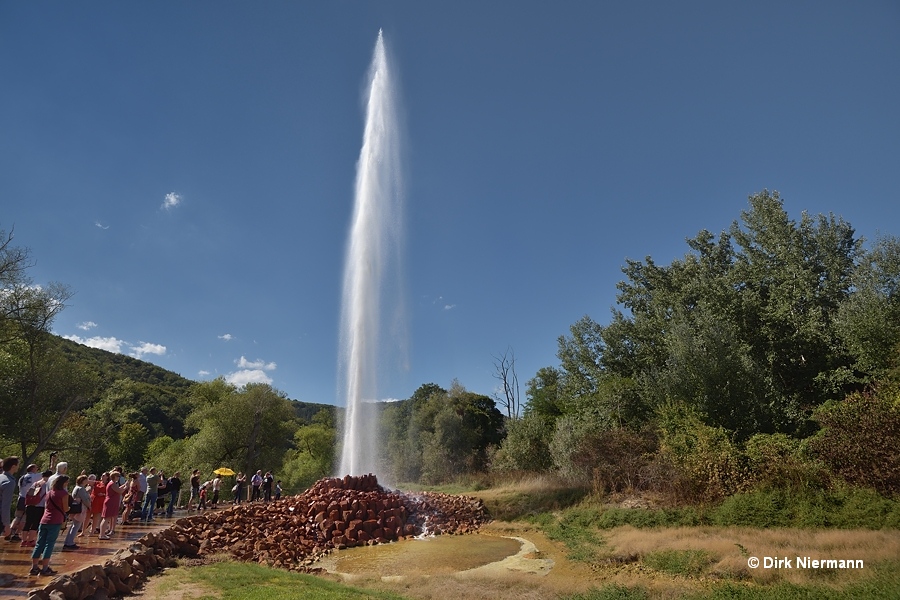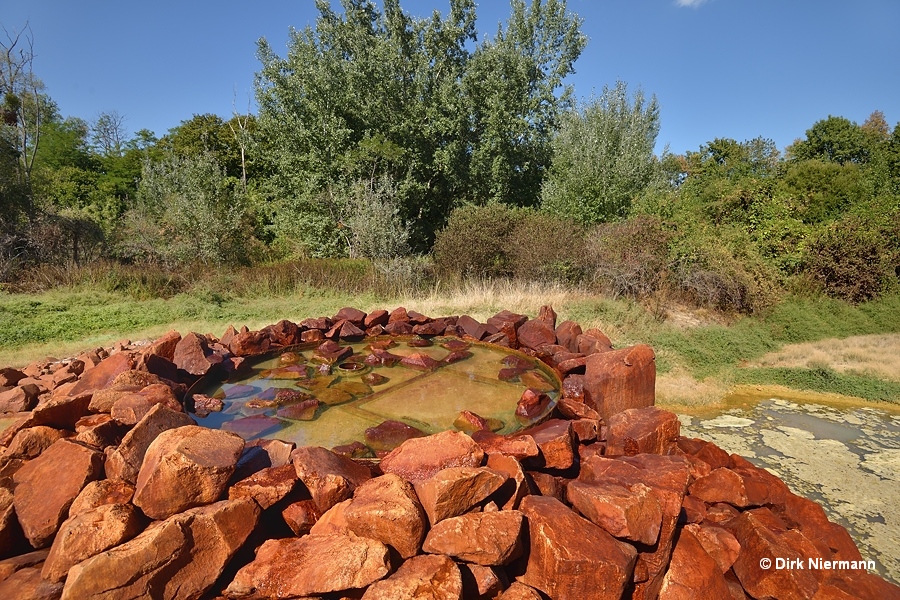Geysir von Andernach
The Geysir von Andernach is the world's largest cold-water geyser. It's driven by a natural phenomenon, namely the accumulation and discharge of volcanic carbon dioxide, thus it's a true volcanic spring. But it is not of natural origin. A 350 m (1148 feet) deep borehole forms the plumbing system for 18 - 21 °C (64 - 70 °F) cold, inflowing groundwater. The groundwater dissolves carbon dioxide gas, released by magma in the depth. When the water gets oversaturated, gas bubbles form and their expansion pushes some water out of the geyser's orifice. The resulting pressure drop in the subterranean water column causes a very quick chain reaction whereby more and more gas bubbles develop and increasingly more water is ejected. It finally reaches a speed of more than 100 km/h (60 mph) and a height around 60 m (197 feet) above ground level.

Although not a feature formed by nature, Geysir von Andernach already has an eventful history. The first borehole, sunk in 1903 on the Rhine peninsula Namedyer Werth northwest of the town center of Andernach to exploit carbon dioxide for sparkling water, surprisingly resulted in the formation of a cold-water geyser. Back then, it was erupting up to 50 m (164 feet) high at an unmanipulated interval around 4 hours. At that time the geyser was called Namedyer Sprudel (freely translated: Namedyer sparkling water) and it already became a popular attraction, but the bottling of sparkling water and of carbon dioxide still was of prime importance. Even if the spouting activity declined during the decades to some extent due to damages mainly caused by the two world wars, the geyser was largely functional until 1957. In 1967 the old, 343 m (1125 feet) deep borehole was closed by a slider and in public the cold-water geyser fell into oblivion for 34 years.
On the initiative of Andernach's tourism promoters a new borehole was drilled in 2001 at a slightly different position and its orifice has been embedded into a presentable geyser mound. A few first visitor tours already took place in July 2006. But only after the city of Andernach agreed upon a sustainable tourism concept with an environmental group in 2009, Geysir von Andernach is regularly active again and a visit is open to everybody. However, because the Namedyer Werth is a nature reserve, access is only permitted by the official ferry service and restricted to 4 tours a day with a maximun of 350 persons per tour.

On November 9th, 2008, Geysir von Andernach earned an entry in the Guinness Book of Records as the world's largest cold-water geyser. The highest eruption ever measured was 61.5 m (202 feet) tall. Of course, the jet does not only depend on the pressure of approximately 35 bar in the depth, but also on diameter and shape of the borehole. Eruptions last around 10 - 15 minutes and discharge up to 8 m3 (2100 gal) of water. Around 95 % of the carbon dioxide gas dissolved by groundwater in the depth is released during an eruption, amounting up to 250 m3 (66,000 gal) in total. In combination with decompression this causes the mineral calcite to precipitate from the ejected water and turns it whitish and cloudy.
This calcite, stained by traces of iron oxide, is precipitated as rust red sinter coating on the geyser mound. If the geyser survives long enough we will also observe the formation of macroscopic travertine sinter structures such as nodules, stalactites or even entire terracette deposites. In this context we are not so much talking about decades but rather about centuries.

However, Geysir von Andernach is not permitted to erupt 12 times per day as its natural interval between 108 and 120 minutes would set, but eruption times are controlled by a valve. It is opened in synchronicity with four guided visitor tours at a quarter past 11 am, a quarter past 1 pm as well as 3 o'clock and 5 o'clock pm. Outside the visiting hours and during the winter break from end of October to end of March the gate valve shuts off the geyser and prevents any water and carbon dioxide discharge. Otherwise, with unregulated eruptions the release of that large, varying amounts of toxic carbon dioxide could pose a threat to animals and not least to humans. If you pay attention you may spot the voluminous clouds of carbon dioxide gas during an eruption by the flickering effect they cause in the open air.

In 2018 researchers sampled subsurface microbes from erupted water of the Geysir von Andernach and found 52 organisms, 15 of them in larger numbers. The ecosystem was dominated by a carbon dioxide fixing achaeon from the new order Candidatus Altiarchaeales, second most abundant was a bacterium from the new phylum Caldiserica, originally known from hot springs. They found that about 0.0018% of the carbon dioxide released by the geyser is fixed in this ecosystem (Bornemann, T.L.V., Adam, P.S., Turzynski, V. et al., Genetic diversity in terrestrial subsurface ecosystems impacted by geological degassing. Nat Commun 13, 284, 2022).